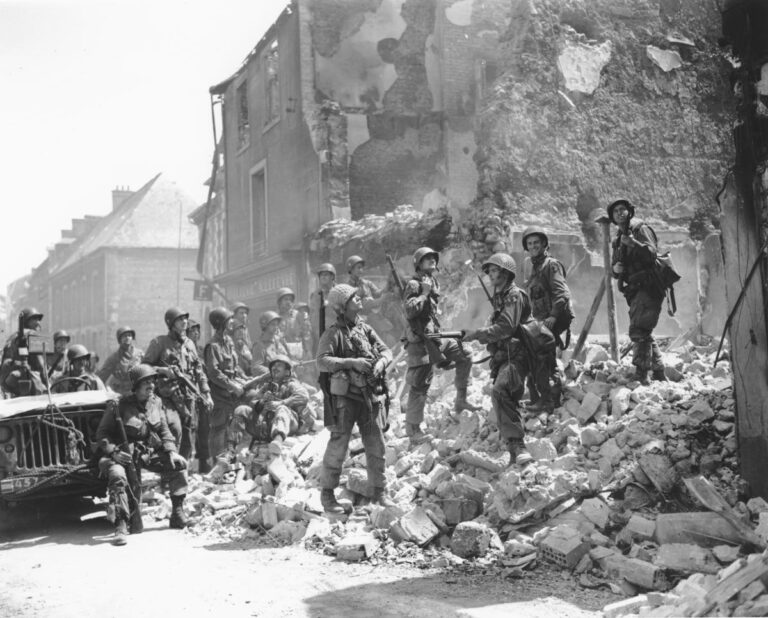CARENTAN-LES-MARAIS, France (AP) – Shortly after D-Day in 1944American soldiers heading into further combat against Adolf Hitler’s forces couldn’t help but notice the starving French boy on the side of the road, hoping for help.
One by one, the men take brightly colored perfumed spheres from their pockets and place them in the hands of Yves Marchais. The 6-year-old had never seen these strange fruits before, having grown up in Nazi-occupied France, where food was rationed and terror was everywhere.
Enthused by his generosity, the young Marchais counted them all – 35 – and rushed home to taste oranges for the first time.
But the massive Allied bombings that pulverized towns, villages and the towns of Caen, Rouen and Le Havre, burying victims and turning the sky fiery red are also etched in the memories of survivors in Normandy.
The 80th anniversary this week of the allied invasion of June 6, 1944 D-Day, which broke through Hitler’s western defenses and helped precipitate the capitulation of Nazi Germany 11 months later, stirs mixed emotions among French survivors of the Battle of Normandy. They stay forever grateful for their release but I cannot forget its high cost in French lives.
Marchais remembers the family home in Carentan, Normandy, shaking during bombings that sounded “like thunder”, and how his mother knocked him unconscious by downing a bottle of strong Norman cider as they were sheltering in their cellar, declaring as they finished: “That’s it. another one that the Germans won’t drink!
“The Americans, for us, were gods,” recalls Marchais, now 86 years old. “Whatever they do in the world, they will always be gods to me. »
NORMANDY’S RUINED CITIES COUNT THEIR DEATHS
Some 20,000 Norman civilians were killed during the invasion and as Allied forces fought their way inland, sometimes field by field through Normandy’s verdant countryside, providing cover for the defenders Germans. Only at the end of August 1944 did they arrive in Paris.
Allied casualties in the Normandy campaign were also terriblewith 73,000 soldiers killed and 153,000 wounded.
The Allied bombings were intended to prevent Hitler from sending reinforcements and to tear his troops away from the “Atlantic Wall” of coastal defenses and other strong points that the German occupation forces had built with forced labor.
The list of Norman towns left in ruins and counting their dead grew with the Allied advances: Argentan, Aunay-sur-Odon, Condé-sur-Noireau, Coutances, Falaise, Flers, Lisieux, Vimoutiers, Vire and others. Leaflets scattered by Allied planes urged civilians to “LEAVE IMMEDIATELY!” YOU DON’T HAVE A MINUTE TO LOSE! but often missed their targets.
Some Normans were furious. Before being released, a woman from the bombed port city of Cherbourg described Allied pilots as “bandits and murderers” in a June 4, 1944, letter to her husband held prisoner in Germany.
“My dear Henri, it is shameful to massacre the civilian population as the so-called Allies are doing,” we can read in the letter that historians Michel Boivin and Bernard Garnier published in their 1994 study civilian victims in the Channel in Normandy.
“We are in danger everywhere.”
NORMAN LOSSES “SWEEPED UNDER THE CARPET”
French President Emmanuel Macron will pay tribute to civilian victims during commemorations on Wednesday in Saint-Lô, a Normandy town that became emblematic of the losses caused by Allied bombings when it was razed to the ground on June 6 and 7, 1944. The death toll stands at 352. , according to Boivin. and Garnier’s study. The playwright Samuel Beckett nicknamed Saint-Lo “the capital of ruins” after working there with the Irish Red Cross.
Among those killed in Saint-Lô were Marguerite Lecarpentier’s older brother, Henri. She was 6 years old at the time. Henri was 19 years old and helping another man pull a teenage girl out of the rubble when the city was bombed again. All three were killed. Marguerite’s father then identified his brother’s body “thanks to his shoes, which were new,” she explained.
When her family then fled Saint-Lô, they crossed what remained of the city.
“It was terrible because there was rubble everywhere,” remembers Lecarpentier. His mother waved a white handkerchief as they walked, “because the planes were constantly flying overhead” and “so that we would be recognized as civilians.”
However, Lecarpentier speaks without rancor about the Allied bombings. “It was the price to pay,” she said.
“It can’t have been easy,” she added. “When we think that they landed on June 6 and that Saint-Lô was only liberated on July 18 and that they lost a lot of soldiers.”
Historian Françoise Passera of the University of Caen, co-author of “The Normans in the War: The Time of Trials, 1939-1945,” says Normandy’s civilian casualties were eclipsed for decades by the exploits of the Allied soldiers in combat and their sacrifices.
Although cities organized commemorations locallyshe noted that it was not until 2014 that a French president – Macron’s predecessor, François Hollande – paid a national tribute to the dead Norman civilians.
Until then, with France having been bombed by its liberators, “it was not a subject that could be raised very easily by the French authorities,” Passera said.
“Civilian casualties have been somewhat glossed over so as not to offend Americans,” she said. “And so as not to offend the British.”
But for the Normans, D-Day and its aftermath were “a bit of a confusion of feelings,” she said. “We cried with joy because we were freed, but we also cried because the dead were all around us. »


